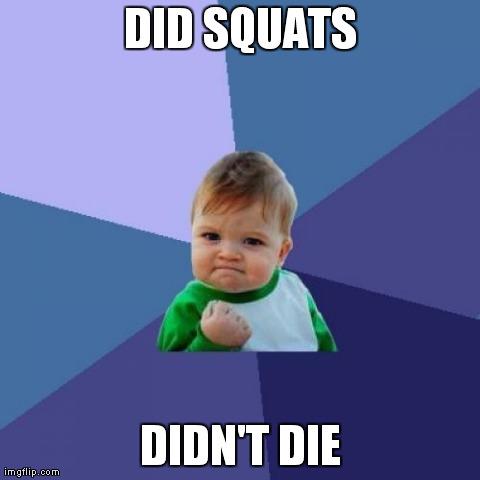Engineering a sleek and powerful physique will require quality time with the squat. Athlete or not, you can’t get away from this movement; it’s one of the fundamentals. My motto is
“Do it well, do it often, and do it heavy”
This wasn’t always the case. I used to loathe squats because they were uncomfortable, awkward and hard – even with my own bodyweight! With time, they got easier, the weights got heavier and I learned to embrace the challenge rather than shun it. If you don’t enjoy squats now, I have good news. You will get better at it, and there’s a variation that’s appropriate for your ability, fitness and comfort level.
Why squat at all?
Why squat?
Why is the sky blue?
Are we really still wondering why it’s important to include squats into your program?
Here’s the deal: Squats enhance your performance in any sport. It’s also a multi-joint compound movement, meaning the energy expenditure is a lot higher than an isolation movement. More energy, more calories, more badass.
The squat should be a staple in your training program. If you can’t squat your own bodyweight with proper form, you have no business trying clean & jerks or BodyPump or getting low on the dance floor. An intelligent training program will feature the squat at least once during a training cycle. Let’s say you lift 3x a week. Your program might spotlight these big lifts like this:
Day 1: Squat
Day 2: Bench press
Day 3: Deadlift
On Day 2 & 3, you might even have some variation of the squat programed after your big lift, meaning you are squatting no matter what.
Programming awesome sauce into your training
Let’s break the squat variations into Phases: novice, intermediate, advanced and performance/enhancement.
Phase 1: The novice
For simplicity’s sake, anyone that is deconditioned, coming back from an injury, or still learning to squat with proper form belongs here. It is possible that someone who works out regularly will be at this level simply because their form and technique is all wrong. In this phase, you practice the squat pattern until it’s ingrained into your muscle memory (aka it comes naturally).
Exercises (in order of progression):
- Bodyweight squat
- Goblet squat
- Bodyweight split squat*
*Note: Unilateral work is imperative in a training program but the challenge to balance and coordination requires that you grove the bilateral (two feet on the ground) squat pattern first
Phase 2: The intermediate
After mastering the novice phase – meaning you can easily do all the novice variations for 10-15 reps with control, ease and proper form – you can move into the next challenging phase. The load makes the movements more difficult, but it can be adjusted depending on your goals.
Exercises (in order of progression and preference):
- Dumbbell squat
- Front squat
- Box squat **
- Rear foot elevated squat (unilateral)
**NOTE: The box squat is not for everyone but it’s here for those with limited mobility who want to improve their back squat. Using a box or bench allows the lifter to measure progress, improve depth at or below parallel and teaches the lifter to ‘sit back’ rather than using the knees/quads to get down.
Phase 3: The Advanced Lifter
Lifters at this stage can train at any phase and ideally you’ll rotate through phases depending on your training cycle and goals. At this point, you’ll be training with the barbell, manipulating the reps, sets, load, and recovery schemes depending on your individual goals.
Exercises: (In no particular order)
- Back squat
- Overhead squat
Phase 4: The Enhancement phase
This phase is optional. It’s unnecessary to train at this level unless the goal is performance specific and/or you’ve mastered Phase 1.
In this phase, you’ll ignite the fast-twitch muscles that enhance explosive power in a movement. The exercises are quick, aggressive in execution, and one hell of a mind/body f**k. Also known as plyometrics, the enhancement phase can be used in addition to an intelligent strength training program either at the end of the workout or in place of a traditional cardio day.
Sample exercises (featuring the squat, duh):
- Tuck jumps
- Broad jumps
- Box jumps
- Jump squats
Now go! Squat like it’s hot! Because it is, damnit!
What’s your favorite squat variation? Share it!

